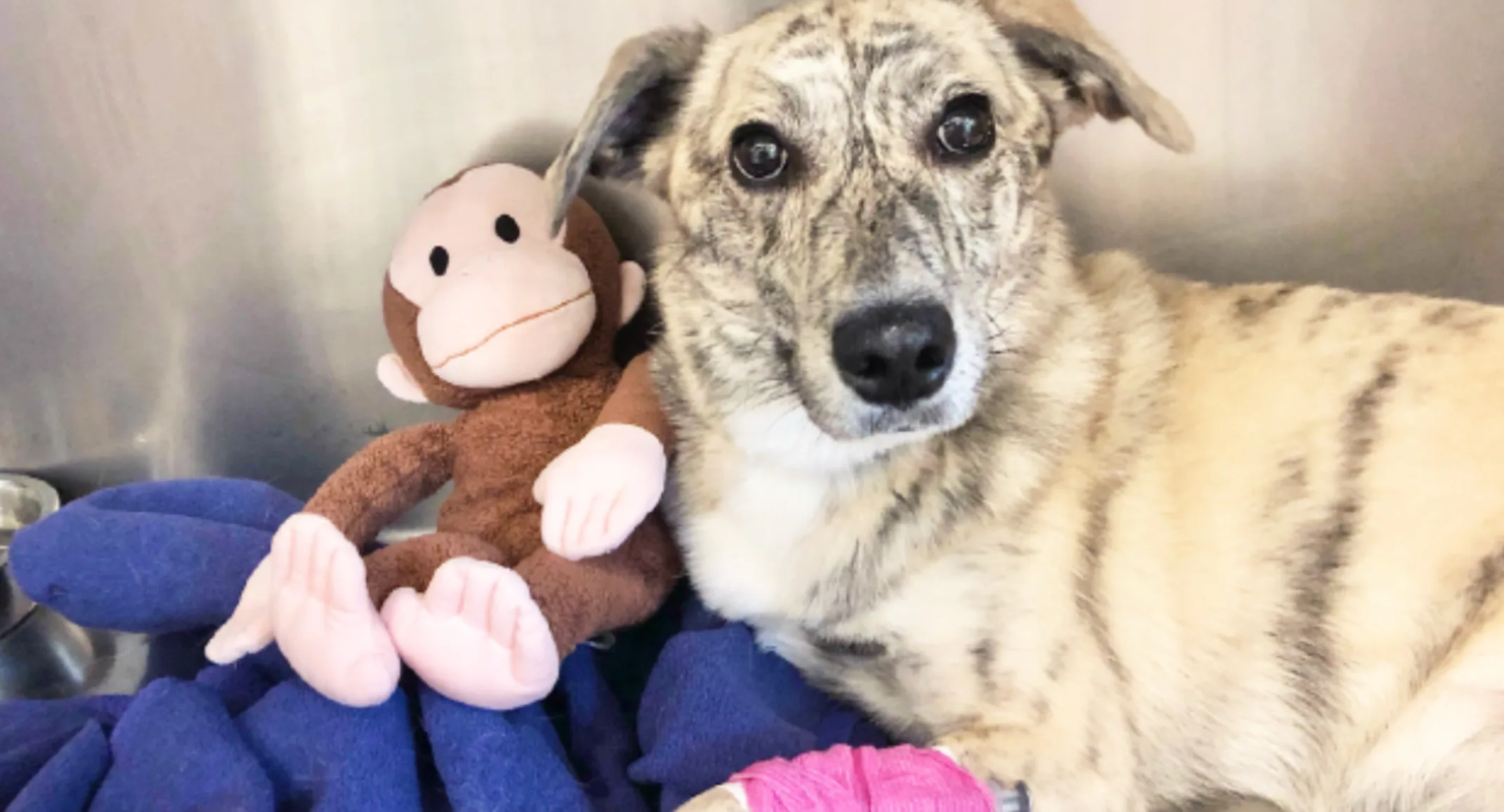Getting Through My Dog’s Heartworm Treatment
Dogs

My poor Callie has had a rough start at domestic life. Her first year with us included a whole spay debacle, a few ear/eye infections, diarrhea episodes, and a foreign body scare. She was what they call a “frequent flyer” at Bulger.
At last, things seemed to be clearing up and I was looking forward to her first smooth-sailing healthy annual exam the following summer.
This day has yet to come.
Diagnosing Heartworm: How Callie Was Infected
In July 2019 at her yearly exam, Callie’s veterinarian at Bulger Veterinary Hospital came back into the room with the results of her SNAP Heartworm RT Test: positive.
I was shocked! We had been so good about giving Callie monthly heartworm prevention since we adopted her. So how did this happen?
RESCUE DOGS & HEARTWORM
Heartworm has a lag time. When a dog is bitten by a mosquito with heartworm, it takes 6-7 months for the larvae to mature into adult heartworms and appear positive in a heartworm test. Callie tested negative for heartworm at the rescue right before we adopted her, but she was likely infected too soon before for it to show up on her test. This is why many veterinarians recommend getting your new rescue dog re-tested for heartworm 6 months after bringing them home. It’s becoming more common to see heartworm positive cases in these Southern rescue dogs!
I was also so caught off guard because Callie had shown no symptoms of having heartworm disease such as coughing, fatigue while exercising, decreased appetite, or weight loss. She was her normal, high-energy self! But there is such a thing as asymptomatic cases which is why it is so, so important to get your dog tested every year.
So we began what I call Callie’s heartworm journey. Now, Melarsomine is the only drug approved for use against adult heartworms and is the only treatment recommended by the American Heartworm Society currently. However, there are other options being researched, such as the Moxidectin-Doxycycline (“Moxi-Doxy”) protocol.
First Try: Moxi-Doxy
The “moxi-doxy” protocol is a newer treatment option that is still being researched. The way it works is your dog is on an oral antibiotic called Doxycycline for 30 days and you begin applying a specific heartworm preventative, Advantage Multi, once a month at home. Over time, the heartworms are killed usually within a few months. Most specialists recommend avoiding strenuous activity for the first few months of treatment.
I opted for this option for Callie knowing that it wasn’t guaranteed to work, but it was much cheaper and less side effects.
THE LONG WAIT
Those 10 months were the longest 10 years of my life. Callie is a mutt, but has a good amount of Border Collie in her. I had severely underestimated how important off-leash exercise and dog playtime was for her. So needless to say, those 10 months were tough for everyone’s sanity. Brain games and puzzle toys can only get you so far with a dog who lives to run.
But alas, we eventually made it and it was time to re-test her. I didn’t really have a good feeling about it, and my feeling was right: she came back positive still.
Note: When Callie started this treatment two years ago, it was still being recommended to keep the dog on an exercise restriction the entire time and re-test after 10 months. More recent publications and studies now recommend only a few months of exercise restriction and re-testing after 15 months of treatment. If we had waited 5 more months to re-test her, perhaps she would have come back negative, perhaps not. That’s the risk you take with an emerging treatment option. Medicine is always changing!
Second Try: Melarsomine
So it was about a year later that we started all over. It was time for the 3-dose melarsomine protocol as recommended by the AHS:
30 days of Doxycycline.
At the end of 30 days, dog goes to hospital and receives 1 melarsomine injection and stays overnight for monitoring. Dog starts exercise restriction.
30 days after the first injection, dog receives 2 melarsomine injections 24 hours apart and stays in hospital for 2 nights.
Dog remains on exercise restriction for 8 more weeks.
6 months after last injection, dog is re-tested for heartworm.
So after another round of Doxycycline for good measure (thank goodness for peanut butter), Callie went back to Bulger for her first melarsomine (a.k.a. immiticide) injection. Melarsomine is an anti-parasitic medication that is injected into the muscle of the dog. It’s generally quite painful and causes a lot of soreness. Callie got her injection that morning, along with some strong anxiety medications to keep my nervous girl as calm and comfortable as possible. She stayed overnight with the ICU team for monitoring to make sure she didn’t have any serious reactions, and I was able to pick her up the next morning.
Her recovery from the first injection was pretty smooth: she was very sleepy and dazed, and napped just about the whole day. Her leg seemed a bit sore too. By the following day, she was bright and alert and ready to play! Which she couldn’t. This time, we were on a much stricter short leash walks-only exercise restriction until her next two treatments. She probably thought we were the most unfair, evil parents ever. No evening walkies up the street? How dare we!? If only I could talk to her.
TIPS FOR KEEPING MY ENERGETIC DOG CALM
snuffle mat (which I hid a few of her kibbles in)
lots of Kong treat toys (I filled hers with peanut butter, froze it overnight, and gave it to her the next day)
what I call her “chewies” (CET Enzymatic oral hygiene chews)
These puzzle toys all helped keep Callie’s brain busy, but honestly it was no replacement for the exercise she needed. I kept these on a rotating schedule so each day she got something different, and at the very least it did help with her frustration and anxiety. I will say be careful of how many treats you’re giving your dog though! Since they’re not exercising, this could cause some weight gain (in Callie’s case it did; we just had to exercise a bit more when all this was over.)
THE TOUGHEST PART
One month later, she went back to Bulger for her final two injections. She received one that morning, stayed overnight, and received another the next morning. Normally, it’s recommended that they stay 2 nights, but based on how she was doing her doctor ok’d her going home that afternoon instead. I was so excited to bring her home and let her rest comfortably in her own bed!
This was by far the toughest part of her heartworm treatment. She started her diarrhea tirade in the back seat of my car on the way home. RIP to that dog car seat cover. The next 48 hours were challenging: she was mentally in another world, in pain, didn’t want to eat, and had uncontrollable liquid diarrhea every couple hours. She slept a lot but couldn’t seem to get comfortable. She wasn’t herself and all I could do was be there for her, shove pain meds down her throat, and tell her that she was going to be okay.
And we got through it! Slowly but surely, she came back to this planet and her leg seemed less sore. She began eating little by little and got back to her normal self. We’re still not sure if the GI upset was a reaction or just her nerves from being in the hospital for so long, but it was all cleared up (thank you, Metronidazole) within a week.
Heartworm Recovery: The Long Wait
We’re actually still waiting on her final result! She will be re-tested in June to confirm that she’s negative, thus ending her heartworm journey. I’ll update this post as soon as we know!
After her 8-week rest period, we slowly increased her exercise from short leash walks, to longer walks, to off leash play and fetch. We’ve all been much happier ever since.
UPDATE JUNE 2021: Callie tested negative for heartworm at her annual exam! Her heartworm journey is officially over.
About Heartworm
Heartworm is a devastating disease transmitted from mosquito bites. The worms themselves are called Dirofilaria immitis, parasites that invade the heart and blood vessels and grow up to 14 inches long (ew!) They can cause lung disease, heart failure, long-term organ damage, or sudden death in dogs, cats, and ferrets.
The exercise restriction during melarsomine treatment is so important. As the heartworms die, they float around in the bloodstream and lodge in the walls of blood vessels. If your dog exercises too hard, the fragments can get shoved into narrowing blood vessels potentially causing a blockage/embolism and even death.
Heartworm prevention is critical and plentiful! There are tons of oral and topical options out there on the market to fit your budget and lifestyle. Talk to your veterinarian to find out which is best for you.
Coming from a pet owner who went through this, you don’t want this. It’s a long treatment protocol, cost us $1,500+, Callie has missed out on lots of adventures, and there’s a possibly of her having long-term damage. Keep your dog on monthly heartworm preventative all year round, put it in your calendar, and don’t miss/skip a dose. And if you’re rescuing a dog, talk to your veterinarian about re-testing them for heartworm.
Heartworm Resources
If your pet has been diagnosed with heartworm, here are some resources to check out:
Written by RACHAEL GILLIS
